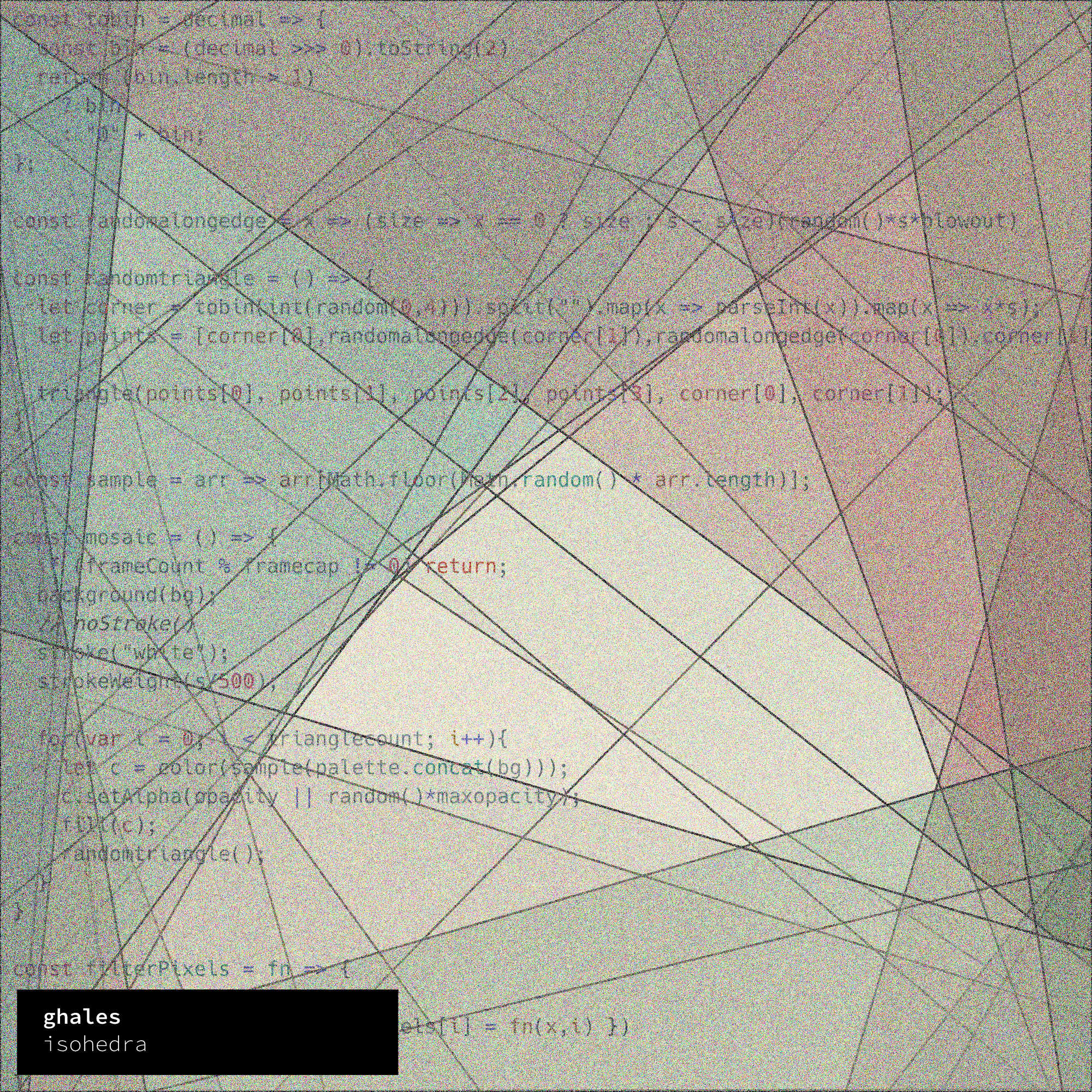

Isohedra
Isohedra is a collection of 6 algorithmically composed pieces inspired by works of digital artist Caleb Ogg. His work resonates a lot with me: it’s quite incredible the way he composes layers, colors, geometry, randomness and tiling into these deliciously intricate and delicate prints - It brings me inner peace, and inspiration to create.
Tracks
A bit about the process. The artworks that inspired each piece (instagram posts) are linked in their title.
1. Confetti Glyphs
The triangles on the image gave me a strong 3/4, playful vibe. I spent a lot of time coding an improvisational drum line, I wanted it to be central to the piece. A marimba can sound playful, so I tried that, and finally, a simple piano harmony to make it tasty. Can’t say I’m into the piano sound, but it’s the best I could do for the time being.
2. Aggregates
This drawing consists of fairly spaced, complex object, with some very interesting layer work. So the sound should be “spaced”, “complex”, and “cold”. I started with a simple melody, which develops into a simple chord melody, with a slightly unexpected harmony.
Then, I added a bass pulse, to add a bit of tension and contemplation, and some random glitches on top for complexity. The last thing was the actual piano harmony - I wasn’t sure what to look for. I experimented with a chord-accompanied phrase, and the result was pretty impressive, becoming a major part of the song.
3. Chromatic Packing
This is based on an older piece on Caleb’s catalog, which despite simple in construction, has a surprisingly intricate result. There are four layers to the piece: three stripe layers in different directions over a circular packing, stacked. So there is a 1-2-3 and 4 movement, and the change in direction indicates a tonal change. From there, I though of a short, tonal-changing, four-note melody loop. There is a pulsating aspect to the piece, I think because of the drastic luminosity contrast, so I went for percussive sounds (congas, plucked bass, piano), and it worked great. Finally, a piano melody on top to give a sense of direction to the piece.
4. Mosaics
This one is really special to me: the way these tiled colors blend gave me a strong Stained Glass vibe, which inspires me a lot (btw, listen to Kayo Dot’s album if you haven’t yet). So I aimed for something that sounded ominous, sacred, and emotional, and also for a glassy sound quality. The harmony came to me first, and I had to top it with a vibraphone / glock circular melody, because yes. I thought a percussion line towards the end would be rewarding, and also give a sense of direction to the piece.
5. Occlude
This piece is a warped noise landscape with a couple colored circles, so it felt jazzy, sophisticated and unapologetic. The warps were represented with a flexatonish, bending vibraphone sound, and the drum groove adds a bit of structure to it. Later, the piano strikes a very imposing chord, defining a tone for the piece - this represents the circles. It plays around with this idea, moving to a random piano bassline at some point. In hindsight, it feels a bit empty, but it’s an interesting idea regardless.
6. Relics
Shortly before composing this one, my friend VV Morais said she wanted to hear more brazilian sounds from me. I thought this piece was a great opportunity to try that: it’s busy, restless, intricate, circular and kind of mechanical. My idea was to start with a bossa-nova base, and kind of “stress-test” it: push it with distortion, polymetrics and tonal superposition until it became barely recognizable. Bonus points if it kept an ironically happy aspect throughout.
So it starts with an improvised drum groove over a guitar base. Then, an orthogonal piano phrase starts, on an entirely different metric, despite starting on the same tone. Later on, chords accompany the piano, conflicting with the established harmony. Some ascending, bubbly melodies come into place, and finally a low, bell-like vibraphone sound, which becomes gradually distorted, overpowering the sound.
Cover
The cover was inspired by his aesthetic. It’s a mesh of random transparent triangles degraded by noise, and filtered. This was coded with p5.js, and later manipulated with GIMP. The js code on the cover describes the algorithm used to create them.
You can hear it on spotify, soundcloud and audius as well.